
Eucalyptus flocktoniae, commonly known as merrit, is a species of tree or mallee that is endemic to Western Australia. It has smooth, silvery grey bark, lance-shaped to curved adult leaves, prominently beaked flower buds in groups of seven or nine and barrel-shaped or urn-shaped fruit.
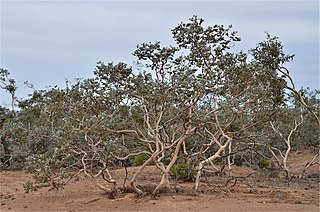
Eucalyptus gillii, known as the curly mallee, Arkaroola mallee, or silver mallee, is a species of mallee or small tree that is endemic to inland Australia. It has smooth bark, sometimes with rough bark near the base, often only juvenile, usually glaucous leaves in the crown, flower buds in groups of between seven and eleven, pale yellow flowers and barrel-shaped or shortened spherical fruit.
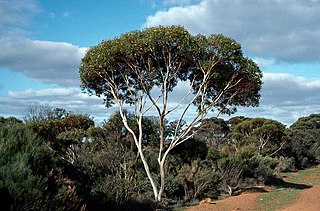
Eucalyptus albida, commonly known as the white-leaved mallee, is a mallee that is endemic to the south-west of Western Australia. It has smooth white or greyish brown bark, lance shaped adult leaves, and flowers in groups of between seven and eleven. The flowers are creamy white and the fruit are hemispherical to cone-shaped. The juvenile leaves that are often retained on mature plants are arranged in opposite pairs, egg-shaped to heart-shaped and bluish grey.

Eucalyptus capillosa, commonly known as wheatbelt wandoo, or mallee wandoo, is a species of tree or mallee that is endemic to Western Australia. It has smooth, grey bark, lance-shaped to elliptic adult leaves, spindle-shaped flower buds in groups of nine to thirteen, white flowers and barrel-shaped to cylindrical fruit.

Eucalyptus herbertiana, commonly known as Kalumburu gum or yellow-barked mallee, is a species of small tree or mallee that is endemic to northern Australia. It has smooth bark, lance-shaped or curved adult leaves, flower buds in groups of seven, white flowers and cup-shaped, hemispherical or conical fruit.

Eucalyptus kessellii, commonly known as Jerdacuttup mallee, is a species of mallee that is endemic to an area along the south coast of Western Australia. It has very hard, rough bark on the trunk of larger specimens, smooth greyish and brownish bark above, lance-shaped to egg-shaped adult leaves, flower buds in groups of three or seven, creamy white flowers and downturned, conical to cup-shaped fruit.
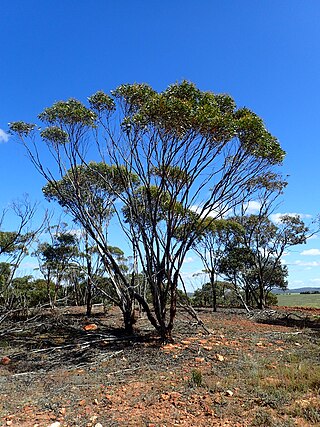
Eucalyptus neutra, commonly known as the Newdegate mallee, is a species of mallee that is endemic to the south-west of Western Australia. It has greyish bark, lance-shaped adult leaves, flower buds usually in groups of seven, pale yellow to white flowers and barrel-shaped to shortened spherical fruit.

Eucalyptus phaenophylla, also known as common southern mallee, is a species of mallee that is endemic to Western Australia. It has smooth bark, linear to narrow lance-shaped or narrow elliptical adult leaves, flower buds in groups of up to thirteen, pale lemon-coloured flowers and barrel-shaped, cylindrical or conical fruit.
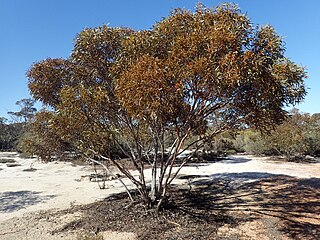
Eucalyptus pileata, commonly known as the capped mallee, is a species of mallee that is native to South Australia and Western Australia. It has smooth greyish bark, narrow lance-shaped adult leaves, flower buds in groups of seven, white flowers and cup-shaped, conical or barrel-shaped fruit.

Eucalyptus platycorys, commonly known as Boorabbin mallee, is a species of mallee, rarely a small tree, that is endemic to Western Australia. It has rough, dark grey, fibrous and flaky bark on the trunk, smooth greyish bark above, lance-shaped adult leaves, flower buds usually in group of three, creamy white flowers and cup-shaped to cylindrical fruit.

Eucalyptus pluricaulis, commonly known as the purple-leaved mallee, is a species of mallee that is endemic to Western Australia. It has smooth bark, dull bluish green, lance-shaped leaves, flower buds in groups of between nine and fifteen, pale yellow flowers and cylindrical to barrel-shaped fruit.
Eucalyptus repullulans, commonly known as chrysoprase mallee, is a species of mallee that is native to arid parts of Western Australia and the far north-west of South Australia. It has smooth bark, lance-shaped adult leaves, flower buds in groups of between seven and thirteen, cream-coloured flowers and cup-shaped, cylindrical or conical fruit.
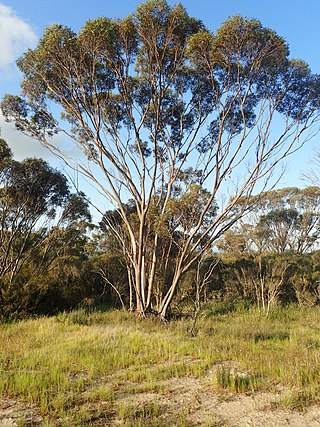
Eucalyptus scyphocalyx, commonly known as goblet mallee, is a species of mallee that is endemic to southern areas of Western Australia. It has smooth bark, lance-shaped adult leaves, flower buds in groups of three or seven, creamy white flowers and cup-shaped to cylindrical fruit.
Eucalyptus singularis, also known as ridge-top mallet, is a species of mallet that is endemic to Western Australia. It has smooth bark, sometimes with ribbons of rough bark at the base, lance-shaped adult leaves, flower buds usually in groups of seven, pale yellow flowers and cylindrical to barrel-shaped fruit.
Eucalyptus tumida is a species of mallee that is endemic to the south coast of Western Australia. It has smooth bark, lance-shaped adult leaves, flower buds in groups of eleven to fifteen, white to pale yellow flowers and cylindrical fruit.
Eucalyptus wyolensis, commonly known as the Wyola mallee, is a species of mallee that is endemic to South Australia. It has rough bark on the base of the stems, smooth grey to brown bark above, heart-shaped to egg-shaped adult leaves arranged in opposite pairs, flower buds in groups of seven to eleven, pale yellow flowers and cup-shaped to barrel-shaped fruit.

Eucalyptus clivicola, commonly known as green mallet, is a species of eucalypt that is endemic to Western Australia. It has smooth bark, linear to lance-shaped adult leaves, flower buds in groups of between nine and thirteen, pale yellow flowers and barrel-shaped, conical or cylindrical fruit.

Eucalyptus crucis is a species of mallee that is endemic to Western Australia. There are three subspecies, commonly known as silver mallee or Southern Cross mallee,, narrow-leaved silver mallee, and Paynes Find mallee,. It has rough bark that is shed in curling flakes, more or less round, glaucous juvenile leaves, egg-shaped intermediate leaves and lance-shaped adult leaves. The type of bark and the proportion of juvenile, intermediate and adult leaves in the crown of mature plants varies with subspecies. The flower buds are arranged in groups of seven in leaf axils, the flowers are whitish to pale yellow and the fruit is a conical to hemispherical capsule.
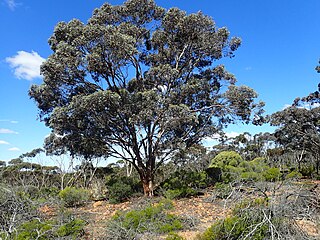
Eucalyptus densa is a species of mallee or mallet that is endemic to Western Australia. It has smooth greyish bark that is shed in curly strips, linear to narrow lance-shaped adult leaves, long, spindle-shaped flower buds in groups of seven or nine, pale yellow or lemon-coloured flowers and conical, cylindrical or barrel-shaped fruit.
Eucalyptus proxima, commonly known as nodding mallee or red-flowered mallee, is a species of mallee that is endemic to a small area in the south-west of Western Australia. It has smooth greyish bark, lance-shaped adult leaves, flower buds in groups of seven, red to pink, sometimes yellowish flowers and conical to slightly bell-shaped fruit.




















